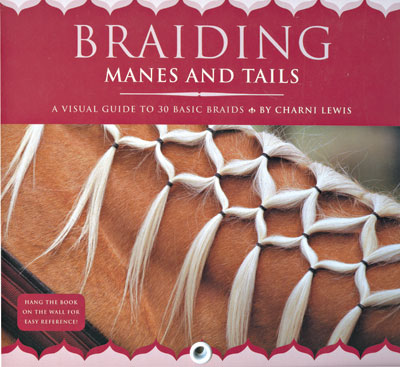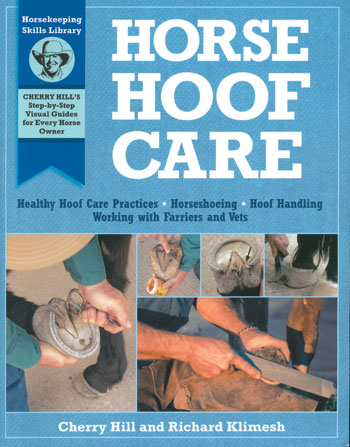 Braiding Manes And Tails
Braiding Manes And Tails
Charni Lewis
Storey Publishing, 210 MASS MoCA Way, North Adams, MA 01247
151 pp. 2007. Color photographs.
$22.95.
I’m a relatively young member of that curmudgeonly crew that loudly laments this generation’s lack of horsemanship. There’s one field in particular that really gets me grumbling: the inability of nearly everyone under the age of 20—or older—to twist a single braid into their horse’s mane.
Having spent hundreds of hours standing on ladders teaching this skill, I understand how difficult it is to learn, and I’ve always wished that an instructional guide existed to get interested braiders started.
So it was with bated breath that I checked out Charni Lewis’ Braiding Manes And Tails, a beautiful volume that covers basic mane and tail care and includes instructions for a dizzying variety of hair-dos for various disciplines, including traditional hunter braids, “eventing knots,” various dressage styles, draft horse mane rolls, western banding and even a few clever novelty braids (but strangely, not unbraiding).
The book even has a hole in the top so you can hang it on the wall while you’re practicing. The book is clearly aimed at beginners and dilettantes, and I picked it up hoping it would provide a solid foundation for future braiders.
Lewis maintains the simple, but not simplistic, tone of a natural teacher, with relatively easy-to-follow instructions and plenty of safety warnings. There are many beautiful photos and carefully drawn diagrams to show which bit of hair is going where.
But the book’s breadth also serves as its downfall, mistreating the two braiding techniques I know best and leaving me wary toward her other instructions.
ADVERTISEMENT
Having braided my way through my junior career (then through college and beyond), I gasped audibly at this volume’s poor coverage of traditional hunter braids. The accompanying photo shows braids of the “who did it and ran” variety, as the professional braiders I know would say.
Worse, the instructions are inaccurate, even for beginners looking to learn just basic technique, and she doesn’t offer instructions for finishing a forelock in the standard style.
Lewis also omits what has become the most popular braiding technique for foxhunters, jumpers and eventers—what I call plaits—deferring instead to a similar but less popular and less attractive “eventing knot.”
Ironically, a gorgeous photo of Eurocommerce Berlin sporting the best braids in the book is plaited in just such a fashion—which you can’t replicate using the book!
In future editions I’d love for the author to consult with a full-time horse show braider (Lewis’ background is in dressage, among other horse sports) to not only shore up the hunter/jumper braids, but also to turn a critical eye toward all the photos to ensure that they portray only spectacular manes and tails instead of the often sufficient displays.
I’d also like to see a few more aspects of practical mane and tail care, including banging and pulling tails, and unbraiding. That being said, this is just the kind of book I wish I’d had when I was spending my Saturday afternoons hanging around at the barn as a pre-teen, and I hope this generation of barn rats finds as much joy in the volume as I would have.
But if they want to braid for a competition they’ll have to find someone who learned from scratch and climb on the ladder next to them to fill in quite a few gaps.
ADVERTISEMENT
 Horse Hoof Care
Horse Hoof Care
Cherry Hill and Richard Klimesh
Storey Publishing, 210 Mass MoCA Way, North Adams, MA 01247
151 pp. 2009. Photographs, illustrations.
$19.95.
Cherry Hill’s newest book in her Horsekeeping Skills Library lives up to its cover, which represents it as an amateur-friendly “step-by-step guide for every horse owner.”
Hill is a longtime trainer and judge, and has seen many examples of poor hoof care. In the introduction, Hill laments the all-too-common presence of fat, shiny, well-loved horses in the show ring forced to cart themselves around with neglected and painful feet.
Often, their owners believe they are taking good care of these animals. To solve this problem, Hill teamed up with certified journeyman farrier Richard Klimesh (also her husband) to produce this easy-to-read yet informative book on hoof care. Novice horse owners are their target audience, but even the experienced horseman can learn something new from this book.
Hill and Klimesh cover just about every facet of hoof care in an organized, logical manner. The anatomy and function of the foot is explained first, providing the reader with a basic understanding so that he or she can get the most out of the rest of the book.
From management, training, tools and shoeing to choosing a good farrier and veterinarian, the information is detailed enough to appear in a college-level equine science textbook but is presented in a way that’s easy for even the greenest horse owner to understand.
Horse shoeing is an art that is thousands of years old and carries with it history and myths that sometimes come into conflict with new practices. Klimesh does a good job of separating fact from fiction while still paying homage to traditional methods of shoeing. He also mentions current “fads” in shoeing but advises that a good trim is a good trim, regardless of its name.
This book is a must-have for any new horse owner and would make a good addition to any horse owner’s library. The text is fun to read, and there are pictures on every page, making it a great reference for kids in Pony Club and 4-H.
Amy Brown






